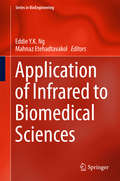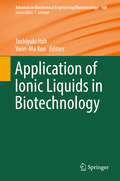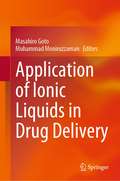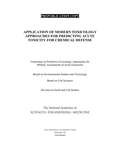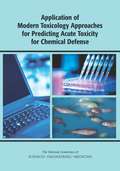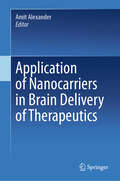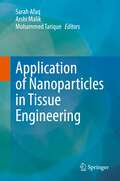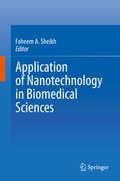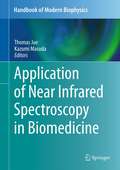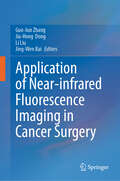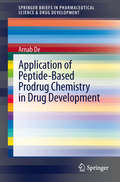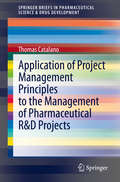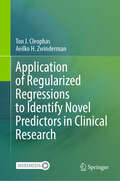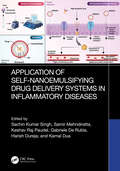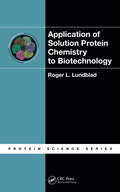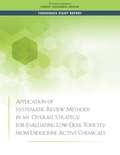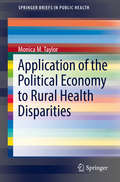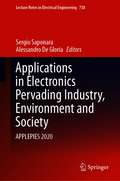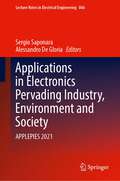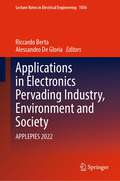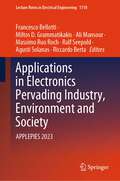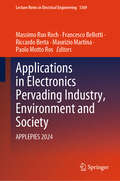- Table View
- List View
Application of Infrared to Biomedical Sciences (Series in BioEngineering)
by Eddie Y. K. Ng Mahnaz EtehadtavakolThe book covers the latest updates in the application of infrared to biomedical sciences, a non-invasive, contactless, safe and easy approach imaging of skin and tissue temperatures. Its diagnostic procedure allows practitioners to identify the locations of abnormal chemical and blood vessel activity such as angiogenesis in body tissue. Its non-invasive approach works by applying the technology of the infrared camera and state-of-the-art software, where high-resolution digital infrared imaging technology benefits highly from enhanced image production, standardized image interpretation protocols, computerized comparison and storage, and sophisticated image enhancement and analysis. The book contains contributions from global prominent scientists in the area of infrared applications in biomedical studies. The target audience includes academics, practitioners, clinicians and students working in the area of infrared imaging in biomedicine.
Application of Ionic Liquids in Biotechnology (Advances in Biochemical Engineering/Biotechnology #168)
by Toshiyuki Itoh Yoon-Mo KooThis volume explores how ionic liquids are used in different areas of biotechnology. It also provides insights on the interaction of ionic liquids with biomolecules and biomaterials. Ionic liquids have become essential players in the fields of synthesis, catalysis, extraction and electrochemistry, and their unique properties have opened a wide range of applications in biotechnology. Readers will discover diverse examples of the application of ionic liquids as solvents for biomaterials extraction and pretreatment, in enzymatic and whole cell catalysed reaction, and as activation agents for biocatalysis. Particular attention is given to the biologically functionalized ionic liquids employed in medical and pharmaceutical applications. Although ionic liquids are considered “green solvents”, the contributing authors will also explore their environmental impact when applied to biotechnology. Chemical, biological and medical scientists interested in ionic liquids and biotechnology will find this work instructive and informative.
Application of Ionic Liquids in Drug Delivery
by Masahiro Goto Muhammad MoniruzzamanThis book presents recent advances in the use of ionic liquids in medicine and pharmaceutics with particular emphasis on addressing critical pharmaceutical challenges, including the low solubility, polymorphism, and bioavailability of drugs. It also provides insights into the development of the biologically functionalized ionic liquids suitable for medical and pharmaceutical applications. Ionic liquids have been used as potential solvents or materials in the fields of pharmaceutical drug delivery and formulations because of their unique and tunable physicochemical and biological properties. Readers find explanations of the diverse approaches to the application of ionic liquids in drug solubility, active pharmaceutical ingredient (API) formulation, and drug delivery systems, such as topical, transdermal, and oral delivery, with particular emphasis on recent developments. Particular attention is given to the development of ionic liquid-assisted effective drug delivery techniques for sparingly soluble or insoluble drug molecules. This book also discusses the biological activities of ionic liquids for possible applications in drug formulation and drug delivery systems. Scientists in disciplines such as chemistry, biology, and pharmaceutics find this book instructive and informative for developing ionic liquid-based drug formulations or drug delivery systems.
Application of Modern Toxicology Approaches for Predicting Acute Toxicity for Chemical Defense
by Committee on Predictive-Toxicology Approaches for Military Assessments of Acute ExposuresThe US Department of Defense (DOD) is faced with an overwhelming task in evaluating chemicals that could potentially pose a threat to its deployed personnel. There are over 84,000 registered chemicals, and testing them with traditional toxicity-testing methods is not feasible in terms of time or money. In recent years, there has been a concerted effort to develop new approaches to toxicity testing that incorporate advances in systems biology, toxicogenomics, bioinformatics, and computational toxicology. Given the advances, DOD asked the National Research Council to determine how DOD could use modern approaches for predicting chemical toxicity in its efforts to prevent debilitating, acute exposures to deployed personnel. This report provides an overall conceptual approach that DOD could use to develop a predictive toxicology system. "Application of Modern Toxicology Approaches for Predicting Acute Toxicity for Chemical Defense" reviews the current state of computational and high-throughput approaches for predicting acute toxicity and suggests methods for integrating data and predictions. This report concludes with lessons learned from current high-throughput screening programs and suggests some initial steps for DOD investment.
Application of Modern Toxicology Approaches for Predicting Acute Toxicity for Chemical Defense
by Committee on Predictive-Toxicology Approaches for Military Assessments of Acute ExposuresThe US Department of Defense (DOD) is faced with an overwhelming task in evaluating chemicals that could potentially pose a threat to its deployed personnel. There are over 84,000 registered chemicals, and testing them with traditional toxicity-testing methods is not feasible in terms of time or money. In recent years, there has been a concerted effort to develop new approaches to toxicity testing that incorporate advances in systems biology, toxicogenomics, bioinformatics, and computational toxicology. Given the advances, DOD asked the National Research Council to determine how DOD could use modern approaches for predicting chemical toxicity in its efforts to prevent debilitating, acute exposures to deployed personnel. This report provides an overall conceptual approach that DOD could use to develop a predictive toxicology system. "Application of Modern Toxicology Approaches for Predicting Acute Toxicity for Chemical Defense" reviews the current state of computational and high-throughput approaches for predicting acute toxicity and suggests methods for integrating data and predictions. This report concludes with lessons learned from current high-throughput screening programs and suggests some initial steps for DOD investment.
Application of Nanocarriers in Brain Delivery of Therapeutics
by Amit AlexanderThis book presents nanoparticles as potential drug delivery carriers for overcoming the blood-brain barrier. The initial chapter of the book discusses complex brain disorders, the currently available therapies, and their limitations. The book discusses the potential applications of polymeric nanoparticles, lipid nanocarriers, liposomes, inorganic nanoparticles, dendrimers, and stimuli-responsive polymers for targeted brain drug delivery. Further, it evaluates the development and role of different cell lines and animal models in brain research. Towards the end, the book reviews challenges, safety, toxicity, regulatory aspects, future possibilities, and constraints in the clinical translation of nanocarrier systems to treat neurological disorders. The book as such provides valuable information to neuroscientists, and researchers working in pharmaceuticals, nanomedicine, drug delivery research, and nanotechnology.
Application of Nanoparticles in Tissue Engineering
by Arshi Malik Sarah Afaq Mohammed TariqueThis book discusses advancements in the applications of nanoparticles in tissue engineering. It examines the applications of nanobiomaterials in hard tissue regeneration, fabrication, and characterization. The book also analyzes the implication of three-dimensional and four-dimensional fabrication techniques for the production of the scaffold in tissue engineering and their advantages over conventional scaffold production techniques. Further, it presents smart materials used in making 4-D scaffolds that imitate the dynamic response of tissue against natural stimuli and adapt to the microenvironment by changing their conformation or other properties. It also summarizes the growing field of biomolecular detection and biosensors in tissue engineering and the increasing prominence of nanoparticles in the biosensors. Further, it provides the future outlook and associated challenges of the application of nanomaterials in tissue engineering.
Application of Nanotechnology in Biomedical Sciences
by Faheem A. SheikhThis book highlights the wide applications of nanomaterials in healthcare and environmental remediation. Presenting nano-based materials that positively influence the growth and proliferation of cells present in soft and hard tissue and are used for the regeneration bone tissue and/or suppression of cancer cells, it also discusses the natural products that can be incorporated in nanofibers for the treatment of cancer. Further, it describes the use of blending and functionalization to produce chitosan nanofibers for biomedical applications, and reviews the role of plasma-enhanced gold nanoparticles in diagnostics and therapeutics. Lastly, the book also introduces various nanotechnology approaches for the removal of waste metabolites in drinking water, and explores the emerging applications of nanorobotics in medicine. Given its scope, this book is a valuable resource for scientists, clinicians, engineers and researchers aiming to gain a better understanding of the various applications of nanotechnology.
Application of Near Infrared Spectroscopy in Biomedicine (Handbook of Modern Biophysics #4)
by Kazumi Masuda Thomas JueIn keeping with the style of the Handbook of Modern Biophysics, this fourth volume, Application of Near-Infrared Spectroscopy in Biomedicine, balances the need for physical science/mathematics formalism with a demand for biomedical perspectives. Each chapter divides the presentation into two major parts: the first establishes the conceptual framework and describes the instrumentation or technique, while the second illustrates current applications in addressing complex biology questions. With the additional sections on further reading, problems, and references, the interested reader can explore some chapter ideas more widely.
Application of Near-infrared Fluorescence Imaging in Cancer Surgery
by Li Liu Guo-Jun Zhang Jia-Hong Dong Jing-Wen BaiThis book provides a comprehensive introduction to the development and application of near-infrared fluorescence (NIRF) in cancer surgery. It thoroughly examines the history, principles, agents, functions, and devices associated with NIRF, along with the latest preclinical research and clinical applications. Special emphasis is placed on the advancements in the second NIRF window and its global implementation in cancer surgery, including innovative molecular imaging technologies in clinical translation. Additionally, the book explores the limitations and potential solutions of NIRF, offering insights into its future trends and perspectives. It serves as a valuable resource for university researchers, surgeons, radiologists, and both undergraduate and graduate students in medicine.
Application of Omic Techniques to Identify New Biomarkers and Drug Targets for COVID-19 (Advances in Experimental Medicine and Biology #1412)
by Paul C. GuestThe COVID-19 pandemic caused by the SARS-CoV-2 virus has affected nearly every country and territory in the world. Although worldwide vaccination efforts have reduced the risk of serious disease outcomes, disparities in distribution have led to multiple waves of SARS-CoV-2 outbreaks and the emergence of variants of concern, some of which have enhanced infectivity and ability to evade existing vaccines. Hence there is an increasing interest in understanding the evolution of viruses like SARS-CoV-2, as well as improving our capacity to effectively current and manage future pandemics.This new volume reviews the most effective omic techniques for increasing our understanding of COVID-19, to improve diagnostics, prognostics, and genomic surveillance, and to facilitate development of effective treatments and vaccines. Chapters are written by an international team of experts and explore methods in the areas of genomics, transcriptomics, proteomics, and metabolomics. Techniques used to assess physiological function at the molecular level and artificial intelligence approaches used for more effective validation and translation of biomarker candidates into clinical use are also discussed. This book is an excellent resource for researchers studying biomarkers, virology, metabolic diseases, and infectious diseases, as well as clinical scientists, physicians, drug company scientists, and healthcare workers.
Application of Peptide-Based Prodrug Chemistry in Drug Development (SpringerBriefs in Pharmaceutical Science & Drug Development)
by Arnab DeMacromolecular (specifically peptide-based) drugs could potentially be highly effective medicines. However they have a relatively short duration of action and variable therapeutic index. An example of such a peptide is Glucagon-like Peptide I which could potentially be used as a revolutionary drug for diabetes. This is because it stimulates insulin only when the blood glucose level is high thereby reducing the risk of hypoglycemia (a significant disadvantage of using insulin is that an insulin overdose is the single most potent cause of life-threatening hypoglycemia). However it's short duration of action (half-life of 2 minutes in plasma) precludes its therapeutic use. In this volume, the use of novel therapeutics like GLP1 as an alternative to tradition insulin-based drugs in diabetes is described. Application of Peptide-Based Prodrug Chemistry in Drug Development elucidates the traditional concept of prodrugs as "specialized non-toxic protective groups used in a transient manner to alter or to eliminate certain limiting properties in the parent small molecule" (IUPAC definition). It goes on to provide insight into how prodrugs of peptides (with GLP1 as an example) could be appropriately used to extend the biological half life, broaden the therapeutic index of macromolecules and improve the pharmacodynamics of such drugs. Author explains the logic behind designing peptide prodrugs, synthetic procedures and bioassays to examine the conversion of the prodrug to the drug under therapeutic conditions. The prodrugs described slowly convert to the parent drug at physiological conditions of 37C and pH 7.2 driven by their inherent chemical instability without the need of any enzymatic cleavage. The diketopiperazine and diketomorpholine (DKP and DMP) strategies for prodrug conversion are demonstrated in detail with special emphasis on the chemical flexibility that it offers to develop prodrugs with variable time actions. This book will be of useful to chemists, biochemists, medicinal chemists, biologists and people in the medical profession (doctors). It may be used in undergraduate classes but will certainly help post-graduate students and advanced professionals. The author is grateful to Prof. Richard DiMarchi (Standiford H. Cox Professor of Chemistry and the Linda & Jack Gill Chair in Biomolecular Sciences at Indiana University) for valuable suggestions. The foreword for the book has been written by Prof. Jean Martinez, (Legion d'Honneur awarded by the French Republic; Professor of Chemistry and Medicinal Chemistry of the University of Montpellier, France; and Chairman of European Peptide Society, 2002-2010).
Application of Project Management Principles to the Management of Pharmaceutical R&D Projects (SpringerBriefs in Pharmaceutical Science & Drug Development)
by Thomas CatalanoDr. Catalano has for the last ten years been doing consulting for the Pharmaceutical Industry. During his consulting he discovered that small businesses such as, generic, startups, and virtual companies do not have the budget or the resources to apply the computer software utilized in project management and therefore do not apply project management principles in their business model. This reduces their effectiveness and increases their operating cost. Application of Project Management Principles to the Management of Pharmaceutical R&D Projects is presented as a paper-based system for completing all the critical activities needed apply the project management system. This will allow these small business to take advantage of the project management principles and gain all the advantages of the system. This book will be beneficial for beginners to understand the concepts of project management and for small pharmaceutical companies to apply the principles of project management to their business model.
Application of Regularized Regressions to Identify Novel Predictors in Clinical Research
by Aeilko H. Zwinderman Ton J. CleophasThis textbook is an important novel menu for multiple variables regression entitled "regularized regression". It is a must have for identifying unidentified leading factors. Also, you get fitted parameters for your overfitted data. Finally, there is no more need for commonly misunderstood p-values. Instead, the regression coefficient, R-value, as reported from a regression line has been applied as the key predictive estimator of the regression study. With simple one by one variable regression it is no wider than -1 to +1. With multiple variables regression it can easily get > +1 or In the past two decades regularized regression has become a major topic of research, particularly with high dimensional data. Yet, the method is pretty new and infrequently used in real-data analysis. Its performance as compared to traditional null hypothesis testing has to be confirmed by prospective comparisons. Most studies published to date are of a theoretical nature involving statistical modeling and simulation studies. The journals Nature and Science published 19 and 10 papers of this sort in the past 8 years. The current edition will for the first time systematically test regularized regression against traditional regression analysis in 20 clinical data examples. The edition is also a textbook and tutorial for medical and healthcare students as well as recollection bench and help desk for professionals. Each chapter can be studied as a standalone, and, using, real as well as hypothesized data, it tests the performance of the novel methodology against traditional regressions. Step by step analyses of 20 data files are included for self-assessment. The authors are well qualified in their field. Professor Zwinderman is past-president of the International Society of Biostatistics and Professor Cleophas is past-president of the American College of Angiology. The authors have been working together for 25 years and their research can be characterized as a continued effort to demonstrate that clinical data analysis is a discipline at the interface of biology and mathematics.
Application of Selected Reaction Monitoring to Highly Multiplexed Targeted Quantitative Proteomics: A Replacement for Western Blot Analysis (SpringerBriefs in Systems Biology)
by Michael Kinter Caroline S. KinterA key experiment in biomedical research is monitoring the expression of different proteins in order to detect changes that occur in biological systems under different experimental conditions. The method that is most widely used is the Western blot analysis. While Western blot is a workhorse in laboratories studying protein expression and has several advantages, it also has a number of significant limitations. In particular, the method is semi-quantitative with limited dynamic range. Western blot focuses on a single protein per sample with only a small number of representative samples analyzed in an experiment. New quantitative tools have been needed for some time to at least supplement, & possibly replace, the Western blot. Mass spectrometric methods have begun to compete with Western blot for routine quantitative analyses of proteins. One of these methods is based on the tandem mass spectrometry technique of selected reaction monitoring (SRM), which is also called multiple reaction monitoring (MRM). Selected reaction monitoring is actually an older tandem mass spectrometry technique, first described in the late 70s, that is widely utilized in the quantitative analysis of small molecules like drugs & metabolites. The use of selected reaction monitoring for the quantitative analysis of proteins has a number of advantages. Most importantly, it is fundamentally quantitative with a wide dynamic range. The output of the analysis is a numerical result that can range over several orders of magnitude. Other advantages include sufficient specificity & sensitivity to detect low abundance proteins in complex mixtures. Finally, selected reaction monitoring can be multiplexed to allow the quantitative analysis of relatively large numbers of proteins in a single sample in a single experiment. This Brief will explain both the theoretical & experimental details of the selected reaction monitoring experiment as it is applied to proteins.
Application of Self-Nanoemulsifying Drug Delivery Systems in Inflammatory Diseases
by Kamal Dua Harish Dureja Keshav Raj Paudel Sachin Kumar Singh Samir Mehndiratta Gabriele De RubisThis book discusses the potential application of self-nanoemulsifying drug delivery systems (SNEDDS) in different inflammatory diseases. It introduces the fundamental principles of SNEDDS, their formulation components, and characterization techniques, providing insights into their mechanisms of drug delivery and formulation optimization. The book also explores the potential of various combination therapies with SNEDDS, highlighting strategies, synergistic effects, and challenges. Furthermore, the chapters in the book highlight the applications of SNEDDS in specific inflammatory diseases, including diabetes, brain diseases, colorectal diseases, cardiovascular diseases, lung diseases, and cancer. Towards the end, the book evaluates the potential toxic effects of SNEDDS components and addresses safety considerations, regulatory aspects, patents, and clinical trials pertaining to SNEDDS. This book is intended for researchers, pharmacologists, pharmaceutical scientists, and clinicians involved in drug delivery and nanomedicine.
Application of Solution Protein Chemistry to Biotechnology (Protein Science)
by Roger L. LundbladReflecting the versatility of the author's science and the depth of his experience, Application of Solution Protein Chemistry to Biotechnology explores key contributions that protein scientists can make in the development of products that are both important and commercially viable, and provides them with tools and information required for successfu
Application of Systematic Review Methods in an Overall Strategy for Evaluating Low-Dose Toxicity from Endocrine Active Chemicals
by Engineering Medicine National Academies of SciencesTo safeguard public health, the US Environmental Protection Agency (EPA) must keep abreast of new scientific information and emerging technologies so that it can apply them to regulatory decision-making. For decades the agency has dealt with questions about what animal-testing data to use to make predictions about human health hazards, how to perform dose-response extrapolations, how to identify and protect susceptible subpopulations, and how to address uncertainties. As alternatives to traditional toxicity testing have emerged, the agency has been faced with additional questions about how to incorporate data from such tests into its chemical assessments and whether such tests can replace some traditional testing methods. Endocrine active chemicals (EACs) have raised concerns that traditional toxicity-testing protocols might be inadequate to identify all potential hazards to human health because they have the ability to modulate normal hormone function, and small alterations in hormone concentrations, particularly during sensitive life stages, can have lasting and significant effects. To address concerns about potential human health effects from EACs at low doses, this report develops a strategy to evaluate the evidence for such low-dose effects.
Application of Systems Thinking to Health Policy & Public Health Ethics: Public Health and Private Illness (SpringerBriefs in Public Health #0)
by Michele Battle-FisherThis book looks at health policy through the lens of public versus private: population health versus the somatic, social, or emotional experiences of a patient. Rather than presenting policy/ethics as overly technical, this book takes a novel approach of framing public and private health in terms of political philosophy, ethics, and popular examples. Each chapter ties back to the general ethics or political literature as applicable, which are not customarily parts of the current public health curriculum. The author's work on the Orgcomplexity blog has touched on this subject by systemically exploring public policy issues, and the tone of this book mimics the blog with an extension of the arguments.
Application of the Political Economy to Rural Health Disparities (Springerbriefs In Public Health)
by Monica M. TaylorThis thought-provoking monograph analyzes the longstanding political and economic structures underlying entrenched health inequities in rural areas worldwide. Bypassing familiar data on the subject, it critiques existing approaches to why core social determinants of health are underrepresented in rural communities, and synthesizes knowledge from health behaviors to spatial politics to make creative, equitable suggestions for intervention. The author reviews classic economic and current sociopolitical theory to pinpoint governments’ decision-making processes behind resource allocation as they translate into poor service access, service quality, and health outcomes. In reply, corrective policy measures are recommended to address these conditions at the root-cause level, in keeping with global goals of improved health for all. <P><P> Included in the coverage: <br>· Rural health disparities: the political economy. <br>· Rural health disparities: the economic argument. <br>· Social disorganization in rural communities. <br>· Rural health disparities and social disorder: public policy responses. <br>· The political economy: an era of institutional cynicism? <P>With its forceful argument for dealing with a growing but often invisible crisis, Application of the Political Economy to Rural Health Disparities makes a significant text for graduate and undergraduate programs in public and international affairs, planning and public policy, public health, public administration, and economics. Public health and advocacy organizations will also benefit from the book’s vision.
Applications in Electronics Pervading Industry, Environment and Society: APPLEPIES 2020 (Lecture Notes in Electrical Engineering #738)
by Alessandro De Gloria Sergio SaponaraThis book provides a thorough overview of cutting-edge research on electronics applications relevant to industry, the environment, and society at large. It covers a broad spectrum of application domains, from automotive to space and from health to security, while devoting special attention to the use of embedded devices and sensors for imaging, communication and control. The book is based on the 2020 ApplePies Conference, held online in November 2020, which brought together researchers and stakeholders to consider the most significant current trends in the field of applied electronics and to debate visions for the future. Areas addressed by the conference included information communication technology; biotechnology and biomedical imaging; space; secure, clean and efficient energy; the environment; and smart, green and integrated transport. As electronics technology continues to develop apace, constantly meeting previously unthinkable targets, further attention needs to be directed toward the electronics applications and the development of systems that facilitate human activities. This book, written by industrial and academic professionals, represents a valuable contribution in this endeavor.
Applications in Electronics Pervading Industry, Environment and Society: APPLEPIES 2021 (Lecture Notes in Electrical Engineering #866)
by Alessandro De Gloria Sergio SaponaraThis book provides a thorough overview of cutting-edge research on electronics applications relevant to industry, the environment, and society at large. It covers a broad spectrum of application domains, from automotive to space and from health to security, while devoting special attention to the use of embedded devices and sensors for imaging, communication and control. The volume is based on the 2021 ApplePies Conference, held online in September 2021, which brought together researchers and stakeholders to consider the most significant current trends in the field of applied electronics and to debate visions for the future. Areas addressed by the conference included information communication technology; biotechnology and biomedical imaging; space; secure, clean and efficient energy; the environment; and smart, green and integrated transport. As electronics technology continues to develop apace, constantly meeting previously unthinkable targets, further attention needs to be directed toward the electronics applications and the development of systems that facilitate human activities. This book, written by industrial and academic professionals, represents a valuable contribution in this endeavor.
Applications in Electronics Pervading Industry, Environment and Society: APPLEPIES 2022 (Lecture Notes in Electrical Engineering #1036)
by Alessandro De Gloria Riccardo BertaThis book provides a thorough overview of cutting-edge research on electronics applications relevant to industry, the environment, and society at large. It covers a broad spectrum of application domains, from automotive to space and from health to security, while devoting special attention to the use of embedded devices and sensors for imaging, communication and control. The book is based on the 2022 ApplePies Conference, held in Genoa, Italy in September 2022, which brought together researchers and stakeholders to consider the most significant current trends in the field of applied electronics and to debate visions for the future. Areas addressed by the conference included information communication technology; biotechnology and biomedical imaging; space; secure, clean and efficient energy; the environment; and smart, green and integrated transport. As electronics technology continues to develop apace, constantly meeting previously unthinkable targets, further attention needs to be directed toward the electronics applications and the development of systems that facilitate human activities. This book, written by industrial and academic professionals, represents a valuable contribution in this endeavor.
Applications in Electronics Pervading Industry, Environment and Society: APPLEPIES 2023 (Lecture Notes in Electrical Engineering #1110)
by Ralf Seepold Miltos D. Grammatikakis Francesco Bellotti Agusti Solanas Riccardo Berta Ali Mansour Massimo Ruo RochThis book provides a thorough overview of cutting-edge research on electronics applications relevant to industry, the environment, and society at large. It covers a broad spectrum of application domains, from automotive to space and from health to security, while devoting special attention to the use of embedded devices and sensors for imaging, communication, and control. The book is based on the 2023 ApplePies Conference, held in Genoa, Italy, in September 2023, which brought together researchers and stakeholders to consider the most significant current trends in the field of applied electronics and to debate visions for the future. Areas addressed by the conference included information communication technology; biotechnology and biomedical imaging; space; secure, clean, and efficient energy; the environment; and smart, green, and integrated transport. As electronics technology continues to develop apace, constantly meeting previously unthinkable targets, further attention needs to be directed toward the electronics applications and the development of systems that facilitate human activities. This book, written by industrial and academic professionals, represents a valuable contribution in this endeavor.
Applications in Electronics Pervading Industry, Environment and Society: APPLEPIES 2024 (Lecture Notes in Electrical Engineering #1369)
by Francesco Bellotti Riccardo Berta Massimo Ruo Roch Maurizio Martina Paolo Motto RosThis book provides a thorough overview of cutting-edge research on electronics applications relevant to industry, the environment, and society at large. It covers a broad spectrum of application domains, from automotive to space and from health to security, while devoting special attention to the use of embedded devices and sensors for imaging, communication, and control. The book is based on the 2024 ApplePies Conference, held in Turin, Italy, on September 19–20, 2024, which brought together researchers and stakeholders to consider the most significant current trends in the field of applied electronics and to debate visions for the future. Areas addressed by the conference included information communication technology; biotechnology and biomedical imaging; space; secure, clean, and efficient energy; the environment; and smart, green, and integrated transport. As electronics technology continues to develop apace, constantly meeting previously unthinkable targets, further attention needs to be directed toward the electronics applications and the development of systems that facilitate human activities. This book, written by industrial and academic professionals, represents a valuable contribution in this endeavor.
